How to Improve Trust & Profits with User-Generated Content (UGC)
How Trust Signals Have the Power to Transform Your Online Reputation, Traffic, and Sales
Building a highly successful, sustainable and ever growing eCommerce business requires a deliberate strategy to build, maintain and grow customer trust at every step of the customer journey, and at every brand touchpoint.
To drive the most trust and credibility possible, you must embrace two main trust strategies; brand-driven trust strategies and 3rd party trust strategies.
Brand-driven trust strategies include things that your brand controls, such as designing a visually attractive website, providing a great user experience, creating high-quality content(images, videos, articles, etc.) to be used on your website, blog, and social media channels.
3rd party trust strategies are becoming ever more important, because they are trust signals that you can’t manipulate or control, which is precisely why consumers perceive them to be highly trustworthy and credible. These strategies include user-generated content and social proof, primarily in the form of ratings and reviews-artfully executed at critical decision points.
By combining these two trust strategies, you can engineer trust, transparency, and authenticity into every facet of your brand, throughout the entire customer journey.

In eCommerce, it’s not just Trust = Sales anymore, but rather Trust ‘Signals’ = Sales. This article is full of pro-tips on how to exponentially accelerate your growth using trust signals, and how they single-handedly have the power to completely transform your online reputation, traffic, and sales.
Let’s begin with a simple premise that we all can agree on: All transactions are inherently based on trust.

The 2021 Edelman Trust Barometer, an annual global survey that ranks rising and falling levels of trust by consumers in several institutions, government, and information sources, has found that overall, trust is at an all-time low.
This may be why people are now, more than ever, turning to online communities and consumer-generated content to find unbiased feedback and trust signals for brands and products that they’re interested in.
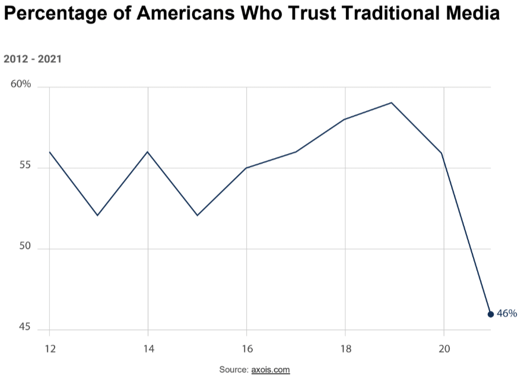
Spokespeople Are Losing Credibility
Below is a chart showing spokespeople in various roles, and the perceived level of credibility that they currently have (percentage based out 100).

Trust in spokespeople is falling-even inside your own organization. This is also true for celebrity “influencers”, where there is a trend to unfollow these disingenuous celebrities who endorse products for money.
Trust In All Information Sources At Record Lows
Below is a chart showing the perceived level or credibility of different types of media, regarding news and information(percentage based out 100, with 60% or above being ‘trusted’).
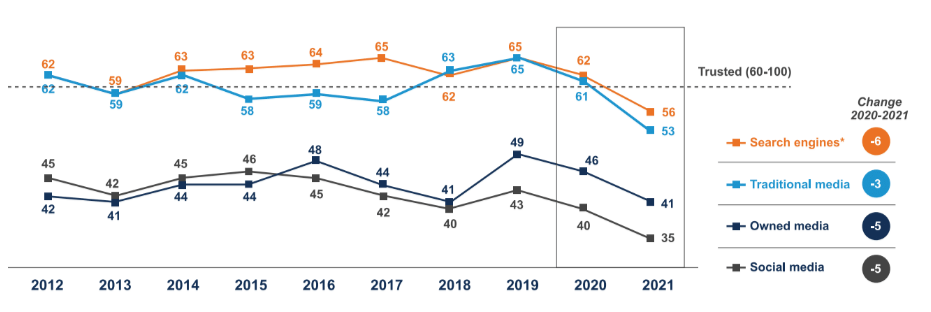
Trust in all information sources is falling, including traditional media, owned media, and social media. This may be directly related to the recent onslaught of political polarization, fake news, and conspiracy theories that have plagued virtually every communication channel.
TRUST IS FUNDAMENTAL
Behavioral and social psychologists and even economists agree that trust is the most fundamental element of personal, professional, business, or political relationships, along with every single type of interaction or transaction. And in fact, without trust, everything fails, including the government, the economy, and commerce itself.

Trust is the fundamental glue that holds it all together; every culture, economy, relationship, and transaction. In fact, the real reason to build a powerful brand preference is to establish a name that people can rely on and trust, in order to facilitate loyalty, and fast and easy decision making.

Sure, a brand may stand for certain attributes, characteristics, beliefs, or causes, but if they don’t also actively incorporate trust as the absolute foundation of their brand, they will eventually lose-especially today.
In a competitive market, fueled by instant access to data, where the consumer is empowered by technology to quickly and easily research all their options, they no longer have the time or interest to do the research to find out if you’re a trustworthy company. Instead, consumers look for reliable trust signals (mental shortcuts) to determine their confidence level in the brand, and if they don’t find them, they leave.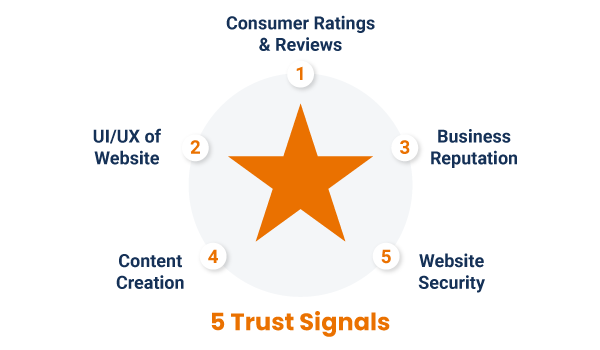
THE 5 TRUST SIGNALS
In this pursuit of faster, more effective ways to establish trust, shoppers look for five main trust signals, both on and off of your website.
These five trust signals include:
- Consumer ratings and reviews across a number of review sites, paying particular attention to the quantity, quality, and source of your ratings and reviews. In addition, what types of reviews you collect and display, where your reviews show up in search, and how you publicly respond to your reviews-especially negative reviews, all play an integral part in how consumers perceive your trustworthiness.
- The look, feel and usability of your website are a visual representation of your company’s trustworthiness. Consumers instantly judge your site on how up-to-date your design feels, the quality and layout of your product images and content, how easy it is to use, and what kind of contact, shipping, and return options are available.
- Your brand's business reputation or BBB ratings and letter grade, as well as industry or 3rd party awards or accolades. They may look at where and how you are mentioned in the press, blogs, forums, or social media. And, they may want to know what trusted experts, insiders and influencers are saying as well.
- The content you create and publish indicates your perceived level of expertise, thought leadership, innovation, vision, network, insights, or solutions. They may want to see your level of engagement or commitment to your social media community, how committed you are to your customers, and how you solve their problems.
- Security measures that you have put in place to protect their information from credit card or identity theft. With hundreds of highly publicized security breaches making headlines each year, it’s no wonder that 1 in every 6 customers abandon their shopping carts right before they buy, due to security concerns. (A great website security option that can help you add instant 3rd party trust and credibility to your site is Trust Guard.)
By looking for these 5 main types of trust signals, shoppers are able to skim through large amounts of content, clutter, and noise in order to quickly determine how trustworthy a business is, which allows them to make better overall decisions, while simultaneously mitigating their losses by avoiding less trusted options.
Not surprisingly, trust signals work both ways. A great example of this is banks. When a financial lender considers giving someone a loan, one of the primary trust signals they look at is a person’s FICO score (credit score), which essentially represents the individual's trust score. The higher the FICO score, the higher the trust, and the lower the interest rates, down payment, security deposit, and the higher the loan limit.
Along these same lines, consumers look at a brand’s trust signals in similar ways. How many ratings and reviews does a company have? What is their overall star rating? What do their customers think about them? Do they take care of upset customers when they have a problem? Do they live up to their claims? Were the majority of their customers happy with their products and/or service?
What this all comes down to-and this is a critical concept for brands to understand-is that the more trust signals you have, and the easier they are for consumers to find...
- The more confidence they will have in your company and your products
- The more likely they will buy from you-the more money they will spend on average
- The more frequently they will buy
- The more likely they are to recommend you to others
In fact, because of the online world that we live in, trust signals have become so important that they are one of the most important and most profitable assets you can possibly have.

TRUST SIGNALS START WITH REVIEWS (SOCIAL PROOF)
If you consider your own shopping and research behavior, it’s almost an automatic, unspoken reaction to ‘stack rank’ and prioritize potential vendors, options, or products based on ratings and reviews from trusted sources. In fact, as consumers, we scour for reviews so automatically and so often, that we don’t even think about it anymore. It’s almost like a subconscious checklist that automatically precedes a purchase.
It’s a lot like how we look people up on LinkedIn or social media before we meet with them, to see how legitimate they are, who they know, what their background is, what they say, and what others are saying about them (social proof). And coincidentally, this is why a lot of gurus talk about the importance of building your personal brand. These days your personal brand is just as important as building a business or product brand. The process of building consumer trust through honest, authentic, and verified reviews has become vital for consumers, individuals, and marketers alike. Lee Reams, wrote this in his recent Forbes article titled, “Trust Isn’t Just An Asset: It’s The Foundation Upon Which Everything Else Is Built”:
“I coach my own clients on the value that reviews bring to the table, both in terms of an increased level of online awareness and with regards to establishing trust, all before a prospect ever has a chance to walk in the door. In reality, these reviews are a psychological trigger. They help you migrate more prospects from the ‘search’ mode to the ‘buyer’ mode in the most efficient way that you can.”
As vitally important as building trust through verified ratings and reviews is for both companies and professionals today, there are many who are not taking an aggressive and proactive approach to establishing their online reputation and growing their brand through an effective review collection, management, and promotional strategy.

DO REVIEWS BUILD TRUST? Absolutely! Definitely! YES!
More than ever before, people rely on reviews and ratings because they make decision-making easier and faster, and they are often the first and primary type of analysis a shopper will use when researching a new brand, seller, or product.
In fact, statistically, 95% of consumers read online reviews, and 91% trust online reviews as much as a personal recommendation.
Ratings and reviews-like a credit score, or any other objective score, rating, or standard of performance-are essentially an efficiency tool that helps us to facilitate faster and easier decision making.
Consider star ratings at hotels for example. Would you seriously consider booking a hotel that you have never stayed at, without looking at their ratings and reviews? Of course not! More than ever, we depend on those ratings to determine things like where we’re going to stay, how much we’re willing to pay, and what we can expect as far as cleanliness, service, and quality. In fact, just having reviews readily available saves us an incredible amount of time and stress, because we know that we can depend on them to make sound, reliable decisions that accurately reflect our wants and needs-all in the shortest amount of time possible.

However, before you can effectively influence a customer’s buying decision, you first need to collect and promote ratings and reviews online that are both authentic and credible. In today’s world, the easiest, fastest, and by far most effective way to do this is with a well-established, highly trusted rating and review platform, like Shopper Approved.

Ratings and reviews are a unique type of User-Generated Content (UGC), that you can leverage both on and off of your website, in order to build and establish trust, credibility, and social proof into your brand, to influence significantly more people to buy from you.
Not only do search engines love this type of UGC and display it virtually everywhere in search, but potential customers love it as well, and base a large portion of their buying decision on it-just like in the hotel example above-to save them time and stress, while increasing the probability of a positive outcome.
The bottom line is that when others endorse you, it’s far more believable and credible than when you endorse yourself. And when you market that customer-driven endorsement, you highly influence other consumer’s buying decisions.
YOUR DIGITAL PROFILE IS CRITICAL
A brand's digital profile mainly consists of the primary search results that a shopper may find online when doing their research, and UGC and 3rd party content is often the foundation of the search results that carry the most visibility and credibility.
In fact, a recent study found that “66% of buyers use sources outside of vendor materials during the research phase.” (Content Marketing Institute and SmartBrief, 2017).
In order to really capture a potential customer’s trust and attention, your digital profile needs to include things like social media channels, apps, maps, directories, merchant ratings and reviews(also known as Seller Ratings), product ratings and reviews, video reviews, media and blog mentions, awards, and recognition, expert opinions, and product Q&A. In other words, what other people are saying about you online is critical to building your digital profile, and your overall success.
Over time, if done properly, your digital profile will create more consumer relevancy, influence, and traffic than your own website, as the following graph explains.
A Seismic Shift In Where People Find Critical Business Content
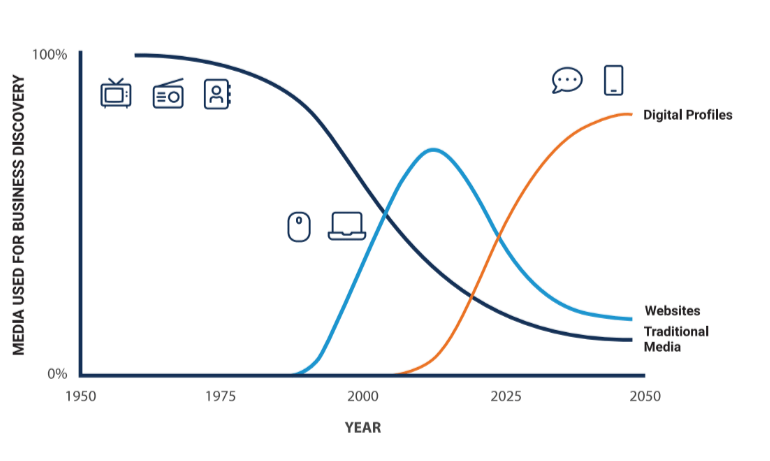
Because of the influential nature of ratings and reviews on your digital profile, reputation management as a marketing and growth strategy has become a critical component of success. In fact, without an effective reputation management program in place, a business may stall, and even fail.
REVIEWS IMPACT THE CUSTOMER JOURNEY
Every shopper goes through some type of process or “journey” to find, research, compare and settle on a brand, product, or service. And depending on the price and complexity of the purchase decision, or how much the decision will impact their money, health, or life, this journey may entail extensive research. The Google ranking algorithm says that any site or content that impacts someone’s money or life, which they call YMYL-Your Money or Your Life, must have ahigh degree of EAT: Expertise, Authority, and Trust, otherwise, it will not rank well in search.
The typical customer journey includes the awareness of a need or want, followed by online research, where they are actively looking for the optimal solution and value, with the least perceived risk.
The research phase is followed by the purchase or conversion phase, where shoppers a reconverted into buyers.
One of the most unique benefits that ratings and reviews have, that no other type of UGC or social proof has, is that ratings and reviews highly influence buyer behavior at all 3 stages of the customer journey.
The Customer Journey Funnel
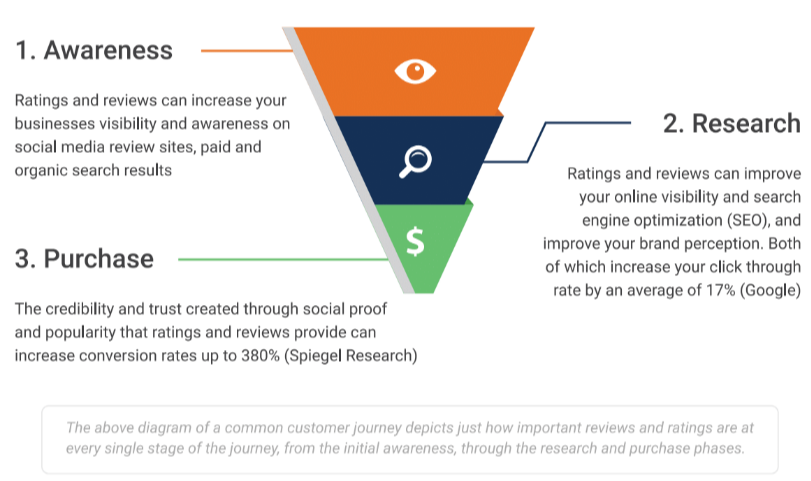
Ratings and reviews can increase your website traffic, product visibility, awareness, and preference in organic search results, social media, review sites, paid ads, and all traditional marketing collateral.
2- Research
Ratings and reviews can improve your online visibility, search engine optimization (SEO), and brand image, which increases your click-through rate by an average of 17% (Google).
3- Purchase
The credibility and trust created through the social proof and popularity that ratings and reviews provide can increase conversion rates up to 380% (Spiegel Research Center).This is a common customer journey that depicts just how important reviews and ratings are at every stage of the journey, from the initial awareness, through the research and purchase phases.
In fact, a comprehensive study conducted by Northwestern Universities Spiegel Research Center found that “...as products begin displaying reviews, conversion rates escalate rapidly. The purchase likelihood for a product with five reviews is 270% greater than the purchase likelihood of a product with no reviews.” And the higher the price, the more critical reviews [are],with reviews for high-priced items increasing conversion rates by up to 380%
Another study by Marketing Sherpa, an independent e-commerce testing company also found that the purchase conversion rate of a test website went from 0.44% before having any star ratings, to 1.04% (a 136% increase) in one part of the study, and from 0.47% to 0.88% (an 87%increase) in another part of the study after the site received its 5-star rating.
- 0.44% Purchase Conversion Rate Without Stars
- 1.04% Purchase Conversion Rate With Stars (136% Increase in Conversion)
These two independent studies using a scientific approach conclude that reviews drive conversions, from an 87%increase up to 380%.
VOLUME MATTERS

A Stanford University study published in Psychological Science found that “people tend to favor a product that has more reviews, even when it has the same low rating as an alternative product.” In other words, the sheer volume of reviews creates credibility by itself, because people prefer to buy “popular” products or buy from popular vendors or stores. In essence, it’s a popularity contest, and creating a mechanism to get more reviews than your competitor can become a winning strategy.
This research is supported by a study by the University of Arizona: “Contrary to what you’d expect, higher product ratings don’t always translate into better sales. Instead, the quantity of product reviews—regardless of whether those reviews are positive or negative—is often much more important in the consumer’s decision process. Simply put, lower-quality products can outsell higher-quality alternatives as long as they collect more reviews.” Assuming, of course, all the reviews are not terrible.
BEING TOO GOOD, IS BAD
A Northwestern University Study found: “When consumers see all five-star reviews, they become skeptical that it’s too good to be true, that there’s some manipulation happening, Therefore... if you have an average star rating in the mid-fours, the purchase probabilities are higher than if it’s at five, which means having some negative reviews in there actually adds credibility.” And in fact, “Purchase likelihood peaks when the average star rating of a product is between 4.2 and 4.5 stars and starts to drop as the star rating approaches a perfect 5. ”
TRANSPARENCY, AUTHENTICITY, AND HONESTY MATTER
A recent study by Review Meta also found that the proliferation of millions of fake 5-star reviews(unverified customer reviews) on Amazon has backfired for the brands using them, and their sales actually decrease with all 4 and 5-star reviews. The review weight, impact, or credibility decreases as the brand gets closer to having all 5-star reviews.
Credibility matters, and as we said from the beginning of this article, consumers are looking for a brand they can trust, which often translates to transparency, authenticity, and honesty. If they smell a skunk (i.e. fake or manipulated reviews), they will run.
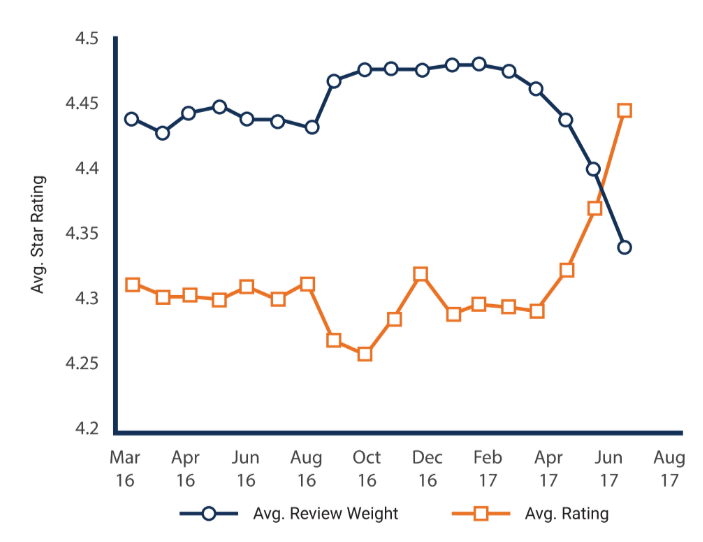
The chart above suggests as average ratings go beyond 4.3 stars you may reach a point of diminishing returns and having all 5-star reviews are seen by the market as a negative.
YOUR SUCCESS STARTS WITH YOUR SEARCH RESULTS
Customer reviews don’t just influence people, they also influence where and how your business is listed and seen in search engine results.
According to Google’s own help document “valid reviews” may show in search results and rich snippets. “A review snippet is a short excerpt of a review or a rating from a review website, usually an average of the combined rating scores from many reviewers. When Google finds valid reviews or rating schema markup, we may show a rich snippet that includes stars and other summary info from reviews or ratings.”

Star ratings can appear in both paid and organic search results if a brand’s website is properly set up with schema markup or structured data, if the site is seen as credible, has over 100 reviews in the past 12 months, and has a 3.5 or higher star rating from a trusted Google Syndication Partner. All other factors being equal, review quantity, recency, and average star rating are the 3 most effective variables to improve your online visibility and traffic in Google.

Some SEO experts believe that online reviews make up over 13% of how Google and other search engines rank local search results. (Chat meter, 2017). SEO MOZ pegs the review impact at 15.44%
So, if you want to become more competitive, and more successful, there is no way around it, you will need to collect as many ratings and reviews as possible, and display them in as many strategic locations online as possible.
5 WAYS TO GET MORE AND BETTER REVIEWS TO IMPROVE YOUR SALES
- Always treat your customers the way you would like to be treated. The golden rule =more gold stars!
- Train your staff on the importance of excellent customer care. Customers won’t care about you unless they know you care about them first.
- Never pay for or incentivize reviews. If Google finds out, they will blacklist your reviews and possibly your website.
- Use a 3rd party Google Review Partner that only collects ‘Verified’ reviews. There are several open review platforms that allow anyone to leave unverified reviews about any business without any proof of purchase. Verified review platforms, on the other hand, only collect reviews from actual paying customers, naturally collect higher star ratings on average, and are more trusted.
- Comment on reviews you receive in a personal, friendly way-especially the bad ones. It will show potential customers you care, and actually increase your trust and credibility, which will lead to more sales.
WHY YOU SHOULD PUBLICLY RESPOND TO REVIEWS
When you publicly respond to reviews, you are accomplishing several very positive objectives that will help your marketing efforts and improve your sales:
- You show the market and your customers that you are listening, responsive, approachable, and that you care about them and your business's reputation, and what people think about it.
- You are creating more content, more desirable keywords, and increasing both consumer and Google trust that will improve your SEO.
- You are thanking your customers for caring enough about your company or product to leave a review, good or bad. This naturally creates customer empathy and engagement.
- You are adding context to the story that helps other prospects better understand your value proposition which facilitates making a decision about your brand.
- You are learning about the things that people like and don’t like about doing business with you.
- You get closer to your customers and make them feel more loyal to your brand.
- You actually encourage other people to leave more and better reviews. A Harvard study with TripAdvisor found that “when hotels start responding, they receive 12% more reviews and their ratings increase”.

HOW TO RESPOND TO REVIEWS
It’s a good idea to respond to 25% to 50% of your reviews, both good and bad. A recent study by Womply found that “Businesses that reply to their reviews at least 25% of the time average 35% more revenue.”
General best practices suggest the following:
- Respond as quickly as possible.
- Respond in a sincere, authentic, and personable tone.
- Always try and see the customer's point of view and frame of reference.
- Double-check for spelling, grammar, and punctuation accuracy.
- Always check your emotional state before writing a response. If you need to collect your thoughts and composure first, do so.
- NEVER USE A TEMPLATED RESPONSE-Consumers see right through this. It’s almost worse than no response at all.
HOW TO RESPOND TO NEGATIVE REVIEWS
You will undoubtedly get a few bad, or less than stellar reviews along the way. It’s only natural because as the saying goes, you can’t please everybody all of the time. So, when the occasional bad review comes in, take it in stride and do your best to turn lemons into lemonade with these simple strategies:
- Apologize. Start by sincerely acknowledging the customer's specific concerns and points of view, even if you don’t agree with them. Show sympathy for any hardship, inconvenience, or difficulty they may have experienced. For example: “I sincerely apologize for your order arriving late. That must have been frustrating.”
- Reframe. Explain what your customers normally experience, and what makes doing business with you so great, such as “While the majority of our shipments arrive on time, sometimes things like this can happen.”
- Simple. Don’t go off on lengthy explanations, and don’t mention your company name, product or location, because you don't want to give the negative review any more SEO juice.
- Offline. Offer to take the conversation offline, and give your email address or phone number, or the name and contact info of the person they should speak with. Example: “We would love to make this right, so please feel free to contact me directly at____________.”
HOW TO RESPOND TO POSITIVE REVIEWS
Just like negative reviews, responding to positive reviews can also have an overall positive effect above and beyond the customer comment and rating. Here are some ways to strategically respond to a positive review:
- Thank. Thank the customer for their business, their positive review, and for the opportunity to serve them. Try to be specific if you can. Example: “Thank you for the wonderful review about your LG TV. It’s our happy customers like you that keep us growing.”
- Keywords. Try to insert specific keywords that you would like to be optimized for search. Such as “The Aftershokz headphones you bought are actually one of the more popular items here at abc.com.”
- Marketing. Add a little marketing message if you can, without feeling forced. Example: “We’re so glad that you’re loving your new Max Air HEPA Room Purifier. It’s a great choice because it removes 99.99% of all the dust, pollen, and odors from your home.”
- Recommendation. Give them an opportunity to take additional action. Example: “If you join our VIP club we can offer free filter upgrades for life.”
- Salutation. Use your name if possible to make your response more personal.
You want to be careful how you put it all together so that your response sounds sincere and natural. The full response may sound something like this:
Hi Rachel,
Thank you for your wonderful review about the Sunny glade 145 Piece Deluxe Art Set you recently purchased. It’s a great option for artists of all ages and levels, and it sounds likely our daughter is really enjoying it. :-)
If you have any questions or would like some advice on art canvas or archival paper to go along with your daughter’s art set, just let us know and we would be happy to point you in the right direction.
We look forward to your next visit.
Thanks again!
Susan P.
Customer Care
abc.com
As you can see this is an entirely different response to what companies typically do.
That’s a good thing! Remember to mix it up. Sometimes you can throw in a marketing message or are commendation, but you want it to sound natural, so don’t do it on every response. The trick is to keep SEO, personalization, marketing, and sincerity all in the back of your mind, then write what feels good, and all of those things will materialize in a natural way.
SUMMARY
Building a strong reputation, and significantly improving your sales, all starts with building trust in your brand. With reviews and ratings being so important to consumers when making a purchase decision online, it’s more important than ever to take control of your success by turning great products and service into rich, relevant customer ratings and reviews that you actively engage with, and strategically display in as many locations as possible, in order to build an unshakeable foundation of customer and brand trust, and significantly increase your traffic and conversions for many years to come.

IMPORTANT KEY FINDINGS FROM OUR RESEARCH
- Star ratings and reviews increase conversion rates up to 380%, especially on higher-priced items where there is more risk.
- More reviews increase trust and conversion rates even higher.
- High volume is more important than ahigh rating alone. A higher volume of average reviews is more valuable than a few 5-star ratings.
- If a brand only has all 5-star ratings, they are seen as untrustworthy and they actually get lower conversion rates.
- Address the problems that create poor reviews and the positive reviews and sales take care of themselves.
- The optimal average star rating is 4.2 to 4.5.
- 90% of respondents who recalled reading online reviews claimed that positive onlinereviews influenced buying decisions, while 86 percent said buying decisions were influenced by negative online reviews. (Dimensional Research)
- 93% of people who use mobile to research go on to complete a purchase of a product or service. Most purchases happen in physical stores. (Google/Nielson)
- Customers are willing to spend 31% more on a business with excellent reviews. (Invesp)
- 94% say an online review has convinced them to avoid a business. (ReviewTrackers)
- Only 13% of consumers will consider using a business that has a 1 or 2-star rating.(SearchEngineLand)
- Four out of five consumers have changed their minds about a recommended purchase after reading negative online reviews. (Cone Communications)
- 82% of consumers read a product review before purchasing an item online. (Qualtrics)
- 97% of shoppers say reviews influence buying decisions. (Fan and Fuel, 2016)
- A bad reputation costs a company at least 10% more per hire. (Harvard Business Review)
- Nearly 95% of shoppers read online reviews before making a purchase. (Spiegel Research Center, 2017)
- 68% of Americans report positive reviews making them more likely to use a business.(BrightLocal, 2017)
- Given two products with similar ratings, consumers are more likely to buy the product with more reviews.(Psychological Science, 2017)
- Reviews produce an 18% uplift in sales. (Revoo, as shared by Econsultancy)
- Displaying reviews can increase conversion rates by 270%. (Spiegel Research Center, 2017)
- 72% of customers don’t take action until they have read reviews. (Testimonial Engine)
- 40% of consumers only consider reviews written within the past 2 weeks. (Wharton, University of Pennsylvania)
- 57% of consumers will only use a business if it has 4 or more stars. (BrightLocal)
- Peer recommendations, original research, and product reviews are the most influential content in affecting purchase decisions. (Content Marketing Institute and SmartBrief, 2017)
- 73% of customers value the written review over the overall star rating (Fan and Fuel, 2016)
- 66% of buyers use sources outside of vendor materials during the research phase.(Content Marketing Institute and SmartBrief, 2017)
- Reputation makes up over 25% of a brand’s market value. (Deloitte, 2012)
- Businesses who reply to reviews at least 25% of the time have an average of 35% more revenue (Womply, 2019)
- 95% of consumers get suspicious of fake reviews if there are no bad scores (Revoo, 2013)
- 68% of customers trust reviews more when they see a mix of good and bad reviews(Broadly)
- 92%of B2B buyers are more likely to purchase after reading a trusted review (G2 and Heinz Marketing, 2017)
- Purchase likelihood improves 15% when buyers read verified buyer reviews over anonymous reviews (Spiegel Research Center, 2017)
- Reviews make 71% of customers more comfortable purchasing a product (3D Cart)
- 87% of American-based consumers need a business to have a minimum star rating of three or higher (out of five) to use it. (BrightLocal, 2017)
Other posts by DJ Sprague
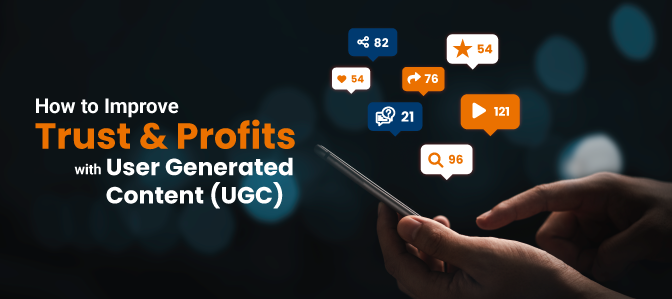
 Drive More Visibility, Traffic, and Sales
Drive More Visibility, Traffic, and Sales
